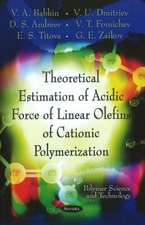Chemical Modification, Properties, and Usage of Lignin
Editat de Thomas Q. Huen Limba Engleză Paperback – mar 2013
| Toate formatele și edițiile | Preț | Express |
|---|---|---|
| Paperback (1) | 1220.75 lei 6-8 săpt. | |
| Springer Us – mar 2013 | 1220.75 lei 6-8 săpt. | |
| Hardback (1) | 1229.91 lei 6-8 săpt. | |
| Springer Us – 31 mar 2002 | 1229.91 lei 6-8 săpt. |
Preț: 1220.75 lei
Preț vechi: 1488.72 lei
-18% Nou
Puncte Express: 1831
Preț estimativ în valută:
233.62€ • 241.34$ • 194.43£
233.62€ • 241.34$ • 194.43£
Carte tipărită la comandă
Livrare economică 26 martie-09 aprilie
Preluare comenzi: 021 569.72.76
Specificații
ISBN-13: 9781461351733
ISBN-10: 1461351731
Pagini: 304
Ilustrații: X, 291 p.
Dimensiuni: 178 x 254 x 20 mm
Greutate: 0.53 kg
Ediția:Softcover reprint of the original 1st ed. 2002
Editura: Springer Us
Colecția Springer
Locul publicării:New York, NY, United States
ISBN-10: 1461351731
Pagini: 304
Ilustrații: X, 291 p.
Dimensiuni: 178 x 254 x 20 mm
Greutate: 0.53 kg
Ediția:Softcover reprint of the original 1st ed. 2002
Editura: Springer Us
Colecția Springer
Locul publicării:New York, NY, United States
Public țintă
ResearchCuprins
1. Starch-Lignin Films.- 2. Lignosulfonic Acid-Doped Polyaniline (Ligno-PaniTM) — A Versatile Conducting Polymer.- 3. Polyurethanes Containing Lignin.- 4. Lignins as Macromonomers for Polyesters and Polyurethanes.- 5. Lignin and Its Polyblends — A Review.- 6. Arboform® — A Thermoplastic, Processable Material from Lignin and Natural Fibers.- 7. Lignin-Based Carbon Fibers.- 8. The Use of Lignosulfonates as Water Reducing Agents in the Manufacture of Gypsum Wallboard.- 9. Modified Kraft Lignin and Its Use for Soil Preservation.- 10. Nitrogenous Fertilizers from Lignins - A Review.- 11. Pulping Catalysts from Lignin - the Diels — Alder Step.- 12. Acetylation of Lignin and Photostabilization of Lignin-Rich Mechanical Wood Pulp and Paper.- 13. Catalytic Modification and Photostabilization of Lignin Functional Groups.- 14. Characteristics, Industrial Sources, and Utilization of Lignins from Non-Wood Plants.










